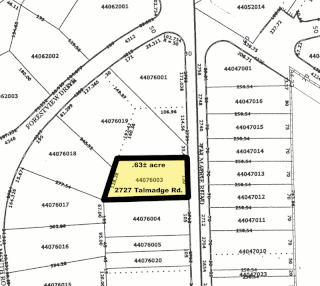Kellersberger's Map is a plat map created in 1854 of Rancho San Antonio on the northeastern shore lands, the Contra Costa of San Francisco Bay, in present day Alameda County, California. The area surveyed today comprises the entire extent of the cities of Berkeley and Albany, and the northern part of Oakland, including its downtown and waterfront.

In the United States, a plat is a map, drawn to scale, showing the divisions of a piece of land. United States General Land Office surveyors drafted township plats of Public Lands Surveys to show the distance and bearing between section corners, sometimes including topographic or vegetation information. City, town or village plats show subdivisions into blocks with streets and alleys. Further refinement often splits blocks into individual lots, usually for the purpose of selling the described lots; this has become known as subdivision.

Rancho San Antonio, also known as the Peralta Grant, was a 44,800-acre (181 km2) land grant by Governor Pablo Vicente de Solá, the last Spanish governor of California, to Don Luís María Peralta, a sergeant in the Spanish Army and later, commissioner of the Pueblo of San José, in recognition of his forty years of service. The grant, issued on August 3, 1820, embraced the sites of the cities of San Leandro, Oakland, Alameda, Emeryville, Piedmont, Berkeley, and Albany.

San Francisco Bay is a shallow estuary in the US state of California. It is surrounded by a contiguous region known as the San Francisco Bay Area, and is dominated by the large cities of San Jose, San Francisco and Oakland.
Contents
The map can be seen here: 1854 Map of the Vicente & Domingo Peralta Ranchos, Lithographed by Britton & Rey, courtesy of Barry Lawrence Ruderman Antique Maps Inc.
Kellersberger's Map was created by surveyor Julius Kellersberger in order to facilitate the subdivision of a portion of the Mexican land grant lands of the Alta California era Rancho San Antonio following the Mexican-American War and U.S. statehood.
The Spanish and later Mexican governments encouraged settlement of the coastal region of Alta California by giving prominent men large land grants called ranchos, usually two or more square leagues, or 35 square kilometres (14 sq mi). Land-grant titles (concessions) were government-issued, permanent, unencumbered property-ownership rights to land called ranchos. The ranchos encompassed virtually all of the most valuable land near the coast, around San Francisco Bay, and inland along the Sacramento River and nearby lands in the Central Valley.

Alta California, known sometimes unofficially as Nueva California, California Septentrional, California del Norte or California Superior, began in 1804 as a province of New Spain. Along with the Baja California peninsula, it had previously comprised the province of Las Californias, but was split off into a separate province in 1804. Following the Mexican War of Independence, it became a territory of Mexico in April 1822 and was renamed "Alta California" in 1824. The claimed territory included all of the modern US states of California, Nevada and Utah, and parts of Arizona, Wyoming, Colorado and New Mexico.

In the United States, a state is a constituent political entity, of which there are currently 50. Bound together in a political union, each state holds governmental jurisdiction over a separate and defined geographic territory and shares its sovereignty with the federal government. Due to this shared sovereignty, Americans are citizens both of the federal republic and of the state in which they reside. State citizenship and residency are flexible, and no government approval is required to move between states, except for persons restricted by certain types of court orders. Four states use the term commonwealth rather than state in their full official names.
Kellersberger had previously surveyed a map of the original claimed extent of the city of Oakland.

Oakland is the largest city and the county seat of Alameda County, California, United States. A major West Coast port city, Oakland is the largest city in the East Bay region of the San Francisco Bay Area, the third largest city overall in the San Francisco Bay Area, the eighth most populated city in California, and the 45th largest city in the United States. With a population of 425,195 as of 2017, it serves as a trade center for the San Francisco Bay Area; its Port of Oakland is the busiest port in the San Francisco Bay, the entirety of Northern California, and the fifth busiest in the United States of America. An act to incorporate the city was passed on May 4, 1852, and incorporation was later approved on March 25, 1854, which officially made Oakland a city. Oakland is a charter city.





